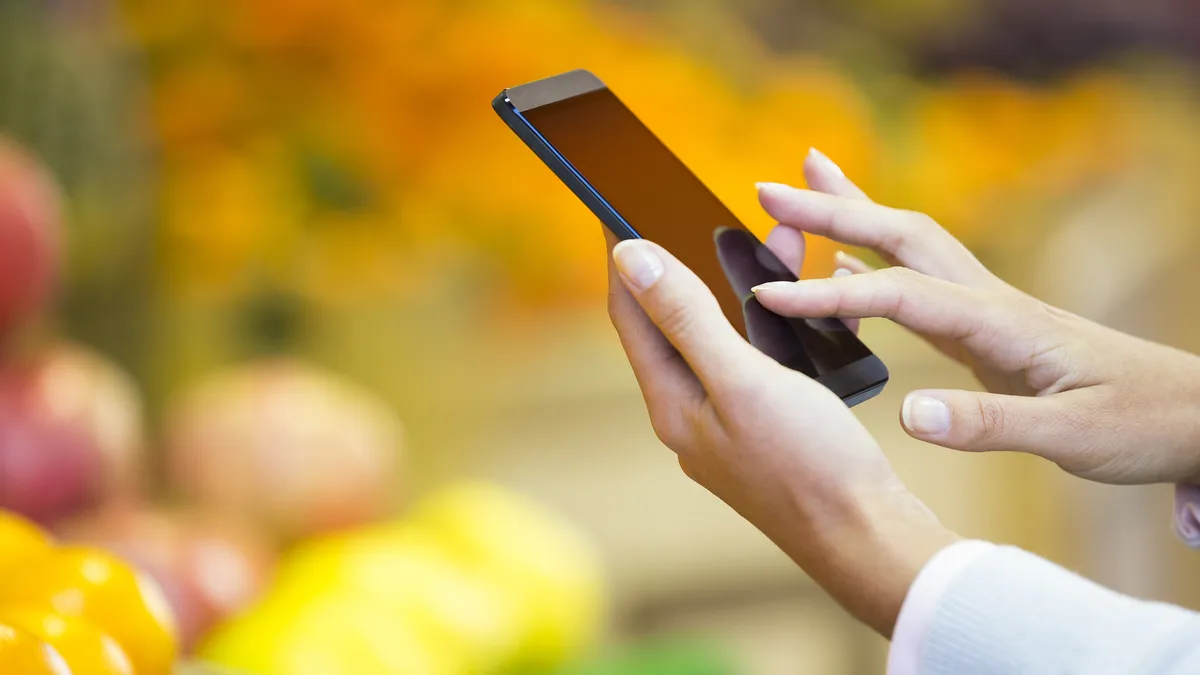Swiping on a smartphone is quick, smooth, and seductive. It can also be a lucrative investment.
Smartphones, urban agriculture, plant-based substitutes — the food industry's rapid change is perhaps most evident in its technology.
What better way to adapt to change than to be at the forefront of innovation and disruption by investing in a food tech startup? At least, that’s what venture capitalists have in mind.
According to CB Insights, U.S. venture capital-backed food tech funding:
- $449 million in Q4 2014
- Series C funding for Instacart ($220 million) and Hampton Creek ($90 million)
- $1.07 billion in 2014, a 272% jump from 2013
As Adam Rothenberg from the venture capital firm BoxGroup points out, the term "food tech" in itself isn’t a "one size fits all" kind of category.
"BoxGroup has made a number of food tech investments to date which have been b2c models and represent unique distribution models or efficiency models in food tech," Rothenberg told Food Dive in an email. "The traditional grocery model is in flux and the consumer has unmet needs that are not satisfied by traditional retail grocery. We look for a strong brand and using technology to facilitate efficient distribution."
'Convenience is the key trend'
While food tech covers an array of different arenas, one thought is clear: the trend relates back to convenience.
“Whether through grocery delivery (a la Ocado / Instacart) meal kits (a la Hello Fresh / Blue Apron) or meal delivery (a la JustEat / Deliveroo) convenience is the key trend," Martin Mignot of Index Ventures said in an email discussion on the race to convenience. "People want to spend less time planning and cooking food and startups are leveraging the new mobile infrastructure (the fact that everyone, including couriers, now own smartphones) to offer highly efficient delivery options of fresh/hot food at low costs."
Food Dive examined the grocery delivery space last month, taking a special look at Instacart.
Kent Bennett of Bessemer Venture Partners, an investor in companies like Blue Apron and Club W, said delivery is the trend and coming up with new models to capitalize on consumer convenience. He said that meal-kit delivery is like a virtual grocery store versus prepared food delivery services, like Sprig, are different, interesting business models that tend to cater to different consumers.
Neil Sequeira of General Catalyst, which helped back NatureBox, noted the food industry’s logistics complications as well as issues in taking care of the product, like spoilage. NatureBox just last week announced $30 million in Series C funding as well as a new vice president of retail sales, Andy Malloy.
He says the biggest trend is meal replacement around busy people and busy lifestyles.
Also, something General Catalyst looks for when investing is the new distribution paradigm of direct to consumer, as opposed to a more complicated traditional supply chain.
This supply chain has many moving parts, but delivery services offer a certain cohesion.
Speaking of businesses like Blue Apron, Bennett said, "You just get a ton of efficiency when you direct connect consumers with producers of food and eliminate the food waste because you get direct shipped exactly the right amount of food to exactly the right amount of people."
John Melas-Kyriazi from Spark Capital also discussed the "consumer experience around food" as a trait it looks for in funding, with Postmates and Kitchen Surfing as examples.
He also noted the mobile trend, with Postmates again as an example as well as Instacart. It’s also made its first food production investment in Freight Farms.
'Not gonna go away'
Michael Dempsey, author of the CB Insights report, mentioned delivery in the space as a big player, with different types like Instacart, Postmates, Munchery, and Maple all playing a part. He added Sprig’s model is particularly interesting, in that it’s both sourcing the food and delivering it, as opposed to UberEats and Postmates that are just logistics providers.
Mignot added, "Fast food 2.0" (ie. Integrated services taking care of everything from the ordering to the cooking to the delivery) are the newest and most advanced concept in terms of convenience and control over the user experience (companies like Sprig or Spoonrocket in the US) but it's still unclear how their margins will evolve and how scalable these models are operationally, as the logistics involved are highly complex."
In terms of the most potential food tech subset, Dempsey said prepared food has a lot of potential funding growth as no one is really taking a hold of the market and is very city to city driven. If multiple restaurants can exist in a city, so can these services, he added.
Mignot thinks food tech’s mobile appeal will push it forward. "The sector has been late to the party and mobile has only now made possible its move from offline to online: this is a secular shift and there is no way back."
Bennett said, "It’s a trillion-dollar plus industry...I think there’s a ton of opportunity. That being said there’s a lot of investment in the space right now. Will it increase? I don’t know, but it’s not gonna go away."
Correction: Spark Capital is not an investor in Hampton Creek. An earlier version said otherwise.
















